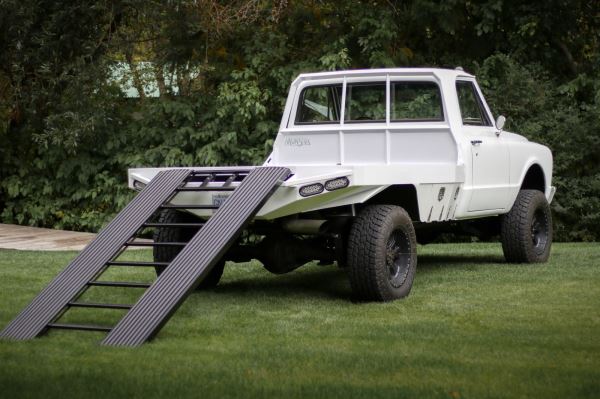
Next, Munster mounted a Pac Brake exhaust brake. “I mounted a button on the shifter so I can engage the air actuated exhaust brake on the fly,” he said. “The switch I used is a snowmobile kill switch that I manufacture.”
After the Dodge 2500 chassis was complete with the rebuilt suspension, Cummins engine and drivetrain, Munster started fitting the C30 cab onto the Dodge chassis.
“The cab came off of a 1969 Chevy C30 motorhome that I acquired with only 26,000 original miles on it,” he explained. “The exterior of the cab was in great shape, but I still had to do a fair amount of rust patching around the rockers and floor pans.”
Munster then replaced the ‘69 front end with a ‘67 style hood, grill and fenders.
“Fitting the Chevy cab to the Dodge chassis wasn't an easy feat,” he explained. “The Dodge front end stuck out much farther than the Chevy, so in order to line up the front wheel with the wheel well of the Chevy cab, I had to cut the front of the Dodge frame shorter and make all new front bumper and cab mounts.”
Now that the grill of the Chevy cab was much closer to the motor, Munster had to move the motor back about three-quarters of an inch and build a whole new radiator and intercooler support.
“There was no room left for the stock fan,” he said. “So I mounted a high flow small electric fan offset from the motor so it would fit.”
The steering and brakes were fairly easy to adapt. Munster only had to do minor modification to the Chevy steering column in order to mount it to the Dodge steering box.
“The whole brake and clutch pedal assembly unbolts as one unit from the Dodge, so I was able to remount it to the fire wall of the Chevy cab, with the master cylinder and all,” he said. “The only mechanical components I ended up keeping from the C30 are the steering column and park brake assembly.”
Finally, Munster added an aluminum flat deck, a product he has built for his snowmobiling customers. “This is a version that I tailored and designed specifically for this truck,” he explained. “Part of the reason for getting rid of the leaf springs was to be able to make deep tool compartments that go right to the frame. Because of the single cab, I needed lots of extra room for storage.”
The compartments are fully sealed. Munster built a heat exchanger on the bottom of the compartments which cycles engine coolant to heat the boxes in the winter. The top deck was designed so the cleats for clamping snowmobiles can be adjusted and removed if needed to put something flat on the deck. The aluminum sled ramp fully tucks away in the back of the deck and pulls out for easy loading.
Munster figures that between two donor trucks, parts and paint, he has spent about $55,000 on the truck and has well over 1,000 hours of time into it.
“I did almost all of the work on the truck myself, with the exception of paint,” he said. “I have painted enough of my own vehicles in the past to learn to just leave it to the professionals.”
Since daily driving was the top priority, most of the changes Munster did to the truck were to improve comfort, drivability and ease of use. “I wanted to make hauling sleds around as easy as possible, ultimately making sledding more enjoyable.”
Munster said the engine and drive train improvements seem to be the most significant features of the truck. “The engine feels very responsive and tight. The suspension is also very firm and the truck handles like a dream. I am very impressed with the way it drives,” he explained.
As for the flat deck, Munster said it is ideal for sled transport because it’s lower than a traditional sled deck, which makes it easier for loading. “You can still fit two sleds side-by-side, but the cab shelters them so they don’t get caked with dirt on the highway.”
Having the sleds on the truck instead of towing a trailer is mandatory when exploring roads and trying to find new access points, Munster explained. Most riding zones in BC are accessed by driving up rough and narrow logging roads with limited parking. The truck itself should do great up the logging roads.
“I plan on installing an ARB Rear Air locker in the near future to help with trenching through snow patches … and maybe the odd burnout,” he said.